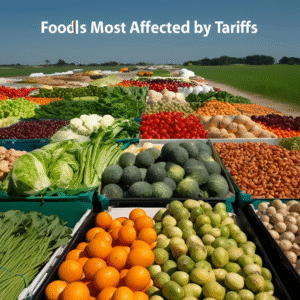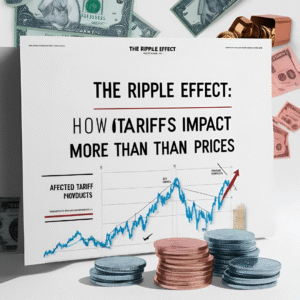Foods Affected By Tariffs
The Price on Your Plate: How Tariffs Affect the Foods We Eat
Foods Affected By Tariffs When we stroll through the grocery store aisles, few of us think about international trade, tariffs, or economic policy. We’re busy scanning for fresh produce, debating between brands, or checking price tags. But lurking behind many of those price stickers is a web of global relationships and decisions — and tariffs are one of the most influential.
In simple terms, a tariff is a tax on imported goods. Governments use tariffs to protect domestic industries, retaliate against foreign trade practices, or raise revenue. But when tariffs hit, they ripple through supply chains, impact farmers and food producers, and — ultimately — change what we see and pay for at the store.
So what foods are affected by tariffs, and how does it all impact us? Let’s dive into the kitchen politics of global trade.
A Forkful of History: Tariffs and Trade Tensions
Food has always been central to global trade. Spices, sugar, tea, and coffee once drove empires. In modern times, food trade reflects a complex system of treaties, partnerships, and, occasionally, disputes.
In recent years, trade tensions — such as those between the U.S. and China, or the U.S. and the European Union — have brought food tariffs back into the spotlight. These disputes often involve billions of dollars in agricultural products.
A prime example? The 2018 U.S.-China trade war saw China impose retaliatory tariffs on American soybeans, pork, and dairy, creating major ripples for U.S. farmers and global markets.
Foods Most Affected by Tariffs
1. Soybeans
Soybeans are among the most significant agricultural exports from the U.S., especially to China. When China slapped tariffs on U.S. soybeans in 2018, American farmers faced a devastating drop in demand. Prices plummeted, unsold crops piled up, and some farmers pivoted to other crops or went bankrupt.
2. Pork and Meat Products
Meat, especially pork, has been a frequent target in tariff battles. For example, when China and Mexico imposed tariffs on U.S. pork, American producers were left scrambling to find new markets. The increased costs meant higher prices for consumers and financial strain for hog farmers.
3. Cheese and Dairy
European tariffs on American cheese (and vice versa) have altered trade patterns and prices. U.S. artisanal cheese producers were hit hard, as tariffs made their products less competitive abroad. Similarly, European dairy exports to the U.S. have faced challenges due to increased duties.
4. Wine and Spirits
Tariffs on French and Spanish wines and Scotch whisky made headlines when the U.S. retaliated against EU subsidies for Airbus. These tariffs (up to 25%) made imported wine and spirits more expensive, pushing consumers toward domestic alternatives and straining international relationships.
5. Olive Oil and Specialty Imports
Imported staples like olive oil, pasta, and gourmet items from Europe have also been caught in the crossfire. When these foods are taxed at the border, their retail prices go up — meaning higher costs for consumers and fewer options in specialty stores.
The Ripple Effect: How Tariffs Impact More Than Prices
• Retail Prices Rise
When tariffs increase the cost of imported food, importers often pass that cost onto retailers — and ultimately to shoppers. This can mean a $15 bottle of wine becomes $20 overnight.
• Supply Chain Disruptions
Tariffs can cause chaos across supply chains. If a major buyer like China stops purchasing U.S. pork or soybeans, the entire production pipeline is disrupted. Storage becomes a problem, prices crash, and producers lose money.
• Job Losses and Farm Closures
Farmers and producers affected by tariffs may struggle to stay afloat. In some regions, the combination of tariffs, bad weather, and falling prices has led to bankruptcies and job losses in the agricultural sector.
• Shifts in Consumer Habits
As prices rise or availability shifts, consumers adapt. Some switch to domestic or cheaper alternatives. Others simply stop buying certain items. Tariffs can change what ends up on our dinner tables.
Domestic Winners and Losers
Tariffs aren’t always bad news — at least for some domestic producers. When imports become more expensive, local farmers or manufacturers might benefit from increased demand. But even that silver lining can be misleading.
For example, if tariffs make imported cheese pricier, domestic cheese might see a boost in sales. But if the ingredients for that cheese (like rennet or packaging materials) are also imported and taxed, costs still rise.
Global Tariff Hotspots: Who’s Hitting Who?
- U.S. vs. China: Soybeans, pork, fruits, nuts, and grains were all targeted.
- U.S. vs. EU: Wine, cheese, butter, yogurt, and even coffee-based drinks were affected.
- India vs. U.S.: Tariffs impacted almonds, apples, and lentils.
These tit-for-tat tariffs don’t just impact billion-dollar companies — they affect small farms, family businesses, and everyday consumers.
Real Stories from the Ground
Jane the Cheese Maker (Vermont)
Jane crafts artisanal cheddar that once sold well in France and Germany. But after EU tariffs on U.S. cheese, her orders dried up. She’s had to lay off staff and refocus on domestic markets.
Carlos the Grocer (California)
Carlos runs a family-owned specialty food store featuring Mediterranean imports. When tariffs raised the price of olive oil and pasta, customers complained — and sales dipped. He’s now sourcing more domestic items but says the loss of variety hurts his business.
Liang the Soybean Farmer (Iowa)
When Chinese tariffs hit, Liang lost his biggest customer. With silos full and prices down, he switched to corn. “I’ve been farming soy for 20 years,” he said. “This trade war forced me to start over.”
What Can Consumers Do?
As shoppers, we have more power than we think:
- Support local producers: Buying domestic helps cushion the blow for farmers affected by trade shifts.
- Be flexible: If imported olive oil is costly, try locally produced alternatives.
- Stay informed: Understanding trade issues helps you make thoughtful decisions — and even influence policy by voting and advocacy.
The Future: Will Food Tariffs Ever Go Away?
It’s unlikely. As long as countries produce, trade, and compete globally, tariffs will remain a tool in the diplomatic toolbox. However, trade agreements like the USMCA (which replaced NAFTA) show that cooperation is possible.
Technology may also help. Vertical farming, lab-grown meat, and plant-based alternatives can reduce dependency on global imports. Still, food is cultural and personal — and consumers want variety.
Foods Affected by Tariffs: Frequently Asked Questions (FAQs)
1. What are food tariffs, exactly?
A food tariff is a tax placed on imported or exported food products by a government. These tariffs can make foreign foods more expensive, protect domestic producers, or act as a political tool in trade disputes.
2. Which foods are most commonly affected by tariffs?
Some of the most frequently affected foods include:
- Soybeans
- Pork and beef
- Cheese and dairy products
- Wine and spirits
- Olive oil and specialty items
These are often targeted because they’re high-value exports or politically sensitive commodities.
3. How do tariffs affect grocery store prices?
Tariffs can raise the cost of imported goods, and those increases are often passed down the supply chain to retailers — and ultimately to you. That’s why you might notice price hikes on imported wine, cheese, or nuts after a trade dispute.
4. Who decides which foods get hit with tariffs?
Governments set tariffs, often through agencies like the Office of the U.S. Trade Representative. Decisions are based on economic strategy, trade imbalances, or retaliation against another country’s tariffs.
5. Are there any benefits to food tariffs?
Yes, in some cases. Tariffs can:
- Protect local farmers from foreign competition
- Encourage domestic production
- Support national food security
However, these benefits often come with trade-offs, like higher prices or reduced variety.
6. Can tariffs lead to food shortages?
Not directly, but they can disrupt supply chains and make certain products less available or more expensive. For example, a heavy tariff on imported olive oil might make it harder to find or afford in stores.
7. How long do food tariffs usually last?
It varies. Some tariffs are temporary, used during trade negotiations, while others can last years. The duration often depends on political relationships and trade agreements.
8. Do food tariffs affect farmers?
Yes — significantly. For example, when China placed tariffs on U.S. soybeans, American farmers lost a major export market, leading to oversupply, falling prices, and financial hardship.
9. What can consumers do about food tariffs?
- Support local producers to offset losses from reduced exports.
- Stay informed about trade issues and vote accordingly.
- Be flexible in your shopping habits — try alternative brands or domestic options when imports become costly.
10. Are food tariffs going away anytime soon?
Unlikely. Tariffs are a long-standing part of international trade. While agreements can ease tensions (like the USMCA), food tariffs will likely remain a negotiation tool in global politics.
Final Thoughts
Next time you bite into a burger, sip on your favorite wine, or shop for cheese, remember: there’s a bigger story behind every product. Tariffs might seem abstract or bureaucratic, but they affect real people — farmers, store owners, families, and you.



o75760
1ge6dl
csh6g3
0s8haw
k58b9n
7yi4mp
Mới thấy báo đưa tin hôm qua, vào đọc thử mà cuốn thật. Trên group Reddit Vietnam Game, người ta bàn JJ Win cả buổi chiều nay, ghê thật! Tối qua không ngủ được, nên thử vào jj win vip, game nhiều chế độ, không bị nhàm chút nào. Net nhà mình hôm nay lag kinh, đang vào thì đứng hình luôn.
02rmt8
pjzelu
Обычно, чтобы найти хорошее онлайн-казино, нужно пройти через массу неудачных попыток. Но тут всё сработало с первого раза. Установил Vodka Casino приложение, получил стартовый бонус, начал играть — и понеслось. Порадовало, что приложение оптимизировано даже под бюджетные устройства, никаких тормозов. А ещё: техподдержка отвечает быстро, без шаблонных фраз. Промокоды не просто обещают — они дают реальный буст к старту. А зеркало всегда доступно, без поиска в интернете. Это казино, которому действительно можно доверять.
37ix9b
famous united statesn poker, best online pokies in united kingdom and slot machine for sale uk, or paypal online do
you tip casino hosts (Shonda) uk
Gracze są pewni niezawodności kasyna VAVADA, które szczyci się licencją Curaçao RN 143168. Ta jurysdykcja zapewnia legalność operatorów gier hazardowych na całym świecie.